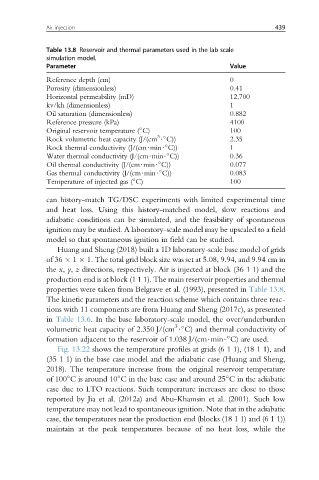Page 475 - Enhanced Oil Recovery in Shale and Tight Reservoirs
P. 475
Air injection 439
Table 13.8 Reservoir and thermal parameters used in the lab scale
simulation model.
Parameter Value
Reference depth (cm) 0
Porosity (dimensionless) 0.41
Horizontal permeability (mD) 12,700
kv/kh (dimensionless) 1
Oil saturation (dimensionless) 0.882
Reference pressure (kPa) 4100
Original reservoir temperature ( C) 100
Rock volumetric heat capacity (J/(cm $ C)) 2.35
3
Rock thermal conductivity (J/(cm$min$ C)) 1
Water thermal conductivity (J/(cm$min$ C)) 0.36
Oil thermal conductivity (J/(cm$min$ C)) 0.077
Gas thermal conductivity (J/(cm$min$ C)) 0.083
Temperature of injected gas ( C) 100
can history-match TG/DSC experiments with limited experimental time
and heat loss. Using this history-matched model, slow reactions and
adiabatic conditions can be simulated, and the feasibility of spontaneous
ignition may be studied. A laboratory-scale model may be upscaled to a field
model so that spontaneous ignition in field can be studied.
Huang and Sheng (2018) built a 1D laboratory-scale base model of grids
of 36 1 1. The total grid block size was set at 5.08, 9.94, and 9.94 cm in
the x, y, z directions, respectively. Air is injected at block (36 1 1) and the
production end is at block (1 1 1). The main reservoir properties and thermal
properties were taken from Belgrave et al. (1993), presented in Table 13.8.
The kinetic parameters and the reaction scheme which contains three reac-
tions with 11 components are from Huang and Sheng (2017c), as presented
in Table 13.6. In the base laboratory-scale model, the over/underburden
volumetric heat capacity of 2.350 J/(cm $ C) and thermal conductivity of
3
formation adjacent to the reservoir of 1.038 J/(cm$min$ C) are used.
Fig. 13.22 shows the temperature profiles at grids (6 1 1), (18 1 1), and
(35 1 1) in the base case model and the adiabatic case (Huang and Sheng,
2018). The temperature increase from the original reservoir temperature
of 100 C is around 10 C in the base case and around 25 C in the adiabatic
case due to LTO reactions. Such temperature increases are close to those
reported by Jia et al. (2012a) and Abu-Khamsin et al. (2001). Such low
temperature may not lead to spontaneous ignition. Note that in the adiabatic
case, the temperatures near the production end (blocks (18 1 1) and (6 1 1))
maintain at the peak temperatures because of no heat loss, while the

